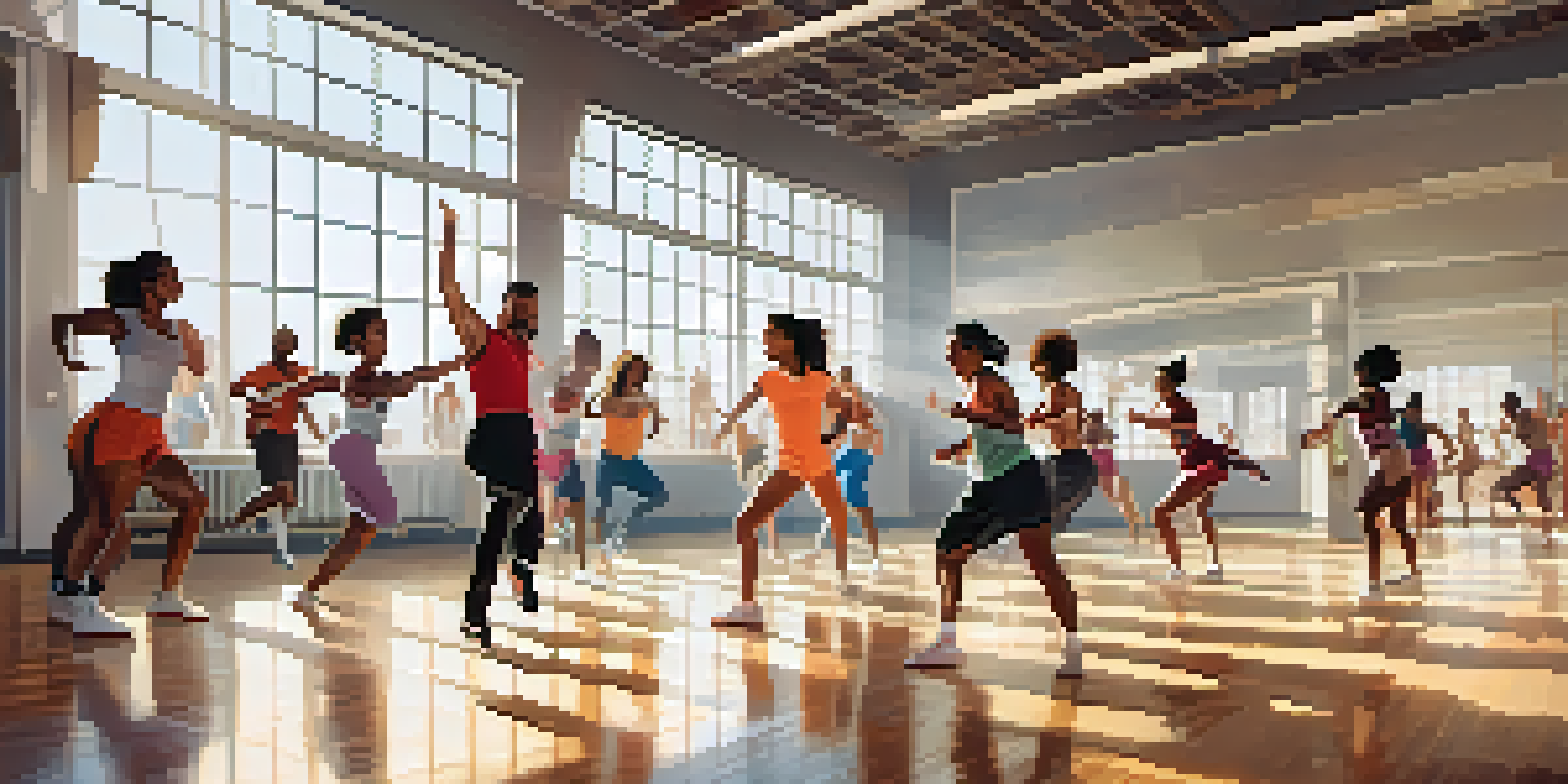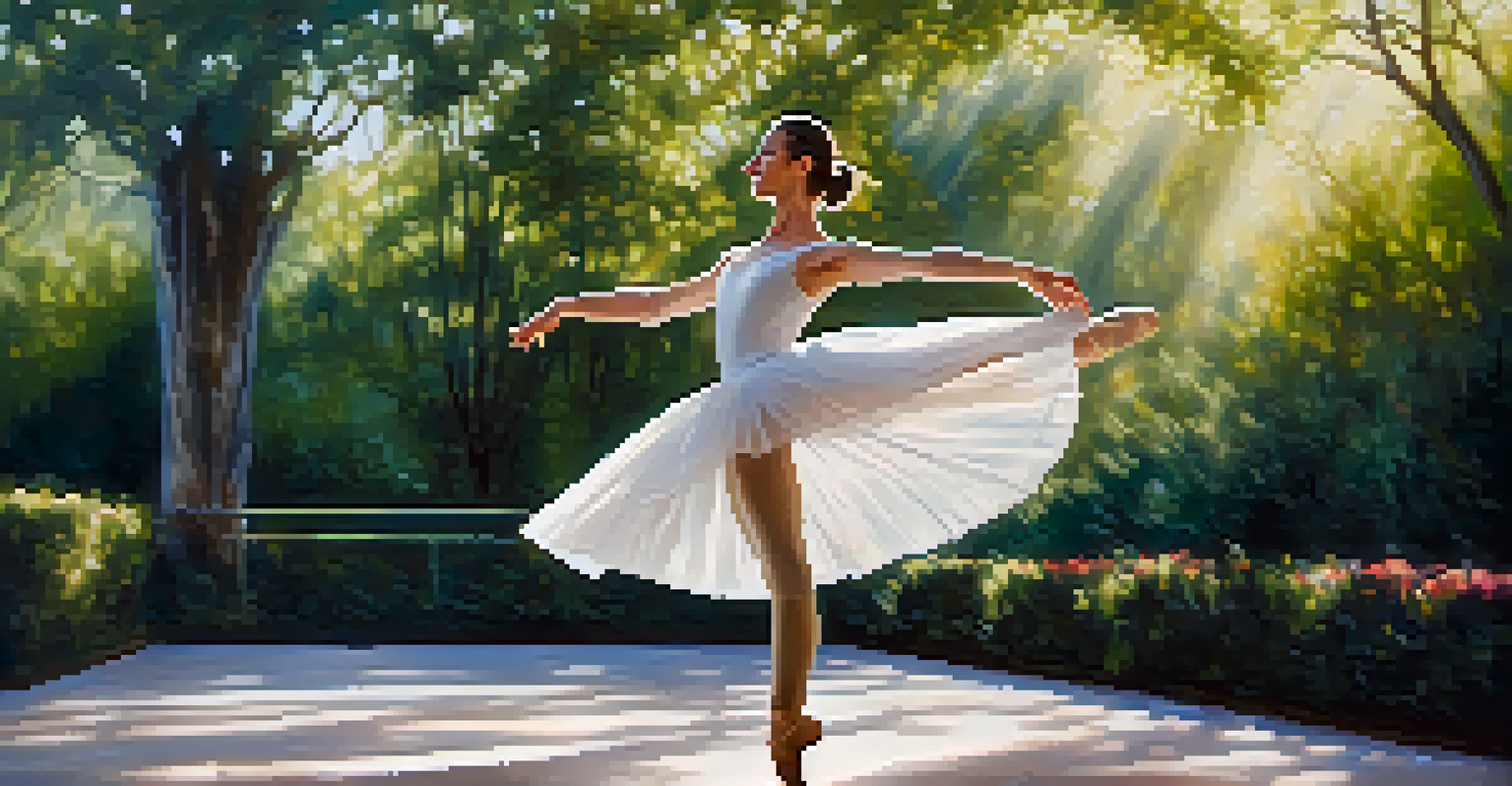The Influence of Dance on Athletic Performance and Training

Understanding the Connection Between Dance and Athletics
Dance and athletics may seem worlds apart, but they share a strong connection. Both require physical strength, coordination, and an understanding of rhythm. Athletes often find that incorporating dance into their training enhances their overall performance. This blend not only improves their physical capabilities but also fosters creativity and expression.
Dance is the hidden language of the soul.
The movement techniques in dance—like balance, agility, and flexibility—can significantly benefit athletes in any sport. For instance, a basketball player can enhance their footwork through dance, making them quicker and more agile on the court. By embracing dance, athletes learn to express their movements gracefully while honing their athletic skills.
Moreover, dance encourages body awareness and control, which are essential for any athlete. It teaches individuals to feel their bodies in space, allowing for better spatial awareness during competition. This unique combination makes dance a valuable asset in athletic development.
The Role of Rhythm in Athletic Performance
Rhythm plays a crucial role in both dance and sports, affecting timing and movement precision. Athletes who have a strong sense of rhythm can often perform their skills more fluidly and efficiently. For example, a runner may find that syncing their strides to a musical beat helps them maintain a consistent pace.

Incorporating rhythmic elements into training can enhance coordination and timing, essential qualities for athletes. Dance training often emphasizes rhythm, allowing athletes to develop these skills in a fun and engaging way. This rhythmic training can lead to improved performance across various sports.
Dance Boosts Athletic Performance
Incorporating dance into training enhances athletes' physical skills, creativity, and expression.
Ultimately, the understanding of rhythm gained through dance can translate into enhanced performance in competitive settings. Athletes who can synchronize their movements with the rhythm of their sport often find themselves performing at a higher level, showcasing the direct link between dance and athletic success.
Enhancing Flexibility and Strength Through Dance
Flexibility and strength are key components of athletic performance, and dance training excels in developing both. Many dance styles require a full range of motion, helping athletes improve their flexibility significantly. For example, ballet dancers often possess incredible flexibility that can benefit athletes in sports like gymnastics or swimming.
The body says what words cannot.
Additionally, dance builds strength in a unique way. The various dance movements target different muscle groups, often engaging core, legs, and arms in a single routine. This comprehensive strength training can lead to better overall athletic performance, as it builds muscle endurance and power.
By integrating dance into their training, athletes not only improve flexibility and strength but also develop a greater appreciation for their bodies. This holistic approach can lead to fewer injuries and a more enjoyable training experience.
Mental Benefits of Dance for Athletes
Athletic performance isn't just about physical strength; it's also about mental toughness. Dance can help athletes build confidence, focus, and creativity, which are crucial for success in any sport. Engaging in dance encourages athletes to express themselves, reducing stress and enhancing mental clarity.
Moreover, learning choreography requires memory and concentration, skills that are transferable to sports. Athletes who practice dance can improve their ability to learn and recall complex plays or routines in their respective sports. This cognitive boost can give them an edge over their competition.
Rhythm Enhances Coordination
A strong sense of rhythm from dance training improves timing and fluidity in athletic movements.
Ultimately, the mental benefits of dance can lead to improved performance under pressure. Athletes who feel confident and focused are more likely to succeed in high-stakes situations, proving that the benefits of dance extend well beyond the physical.
Injury Prevention Through Dance Techniques
Injuries are a common concern for athletes, but dance techniques can help mitigate this risk. Many dance practices emphasize proper alignment and body mechanics, teaching athletes how to move correctly to avoid injuries. By incorporating these principles, athletes can enhance their overall safety during training and competition.
Furthermore, the focus on flexibility and strength in dance can lead to stronger, more resilient muscles and joints. This improved physical condition can help athletes withstand the demands of their sport, reducing the likelihood of injuries. For example, a dancer's strong core can provide stability, which is equally valuable for a soccer player.
Ultimately, the injury prevention strategies learned through dance can be vital for athletes looking to maintain their performance levels. By integrating dance into their routines, athletes can develop the tools needed to protect their bodies while still pushing their limits.
Teamwork and Communication in Dance and Sports
Teamwork is essential in both dance and sports, fostering camaraderie and effective communication. Dance often involves group routines where members must work together harmoniously, mirroring the teamwork required in team sports. This collaboration helps athletes develop trust and understanding with their teammates.
In addition, the communication skills gained through dance can translate into better interactions on the field or court. Athletes who are accustomed to coordinating their movements with others in dance may find it easier to anticipate teammates' actions during games. This heightened awareness can lead to improved teamwork and overall performance.
Dance Aids Injury Prevention
Dance techniques promote proper alignment and body mechanics, helping athletes reduce injury risks.
Ultimately, the social aspect of dance can enrich an athlete's experience, making training more enjoyable and effective. By fostering a sense of community through dance, athletes can cultivate strong relationships that enhance their performance and commitment to their sport.
Integrating Dance into Athletic Training Programs
Integrating dance into athletic training programs can yield numerous benefits, but it requires thoughtful implementation. Coaches should consider including dance classes or workshops as part of their training regimen to expose athletes to the advantages of this practice. This could involve partnering with local dance studios or hiring instructors to lead sessions.
Athletes can benefit from a variety of dance styles, from ballet to hip-hop, each offering unique advantages that can complement their training. For example, a football player might find agility drills in jazz dance helpful for improving footwork, while a swimmer could benefit from the flexibility training in ballet. Mixing different styles can keep training fresh and engaging.

As more athletes and coaches recognize the value of dance in performance, its incorporation into training programs will likely become more common. This holistic approach can lead to well-rounded athletes who are not only physically capable but also mentally sharp and confident.